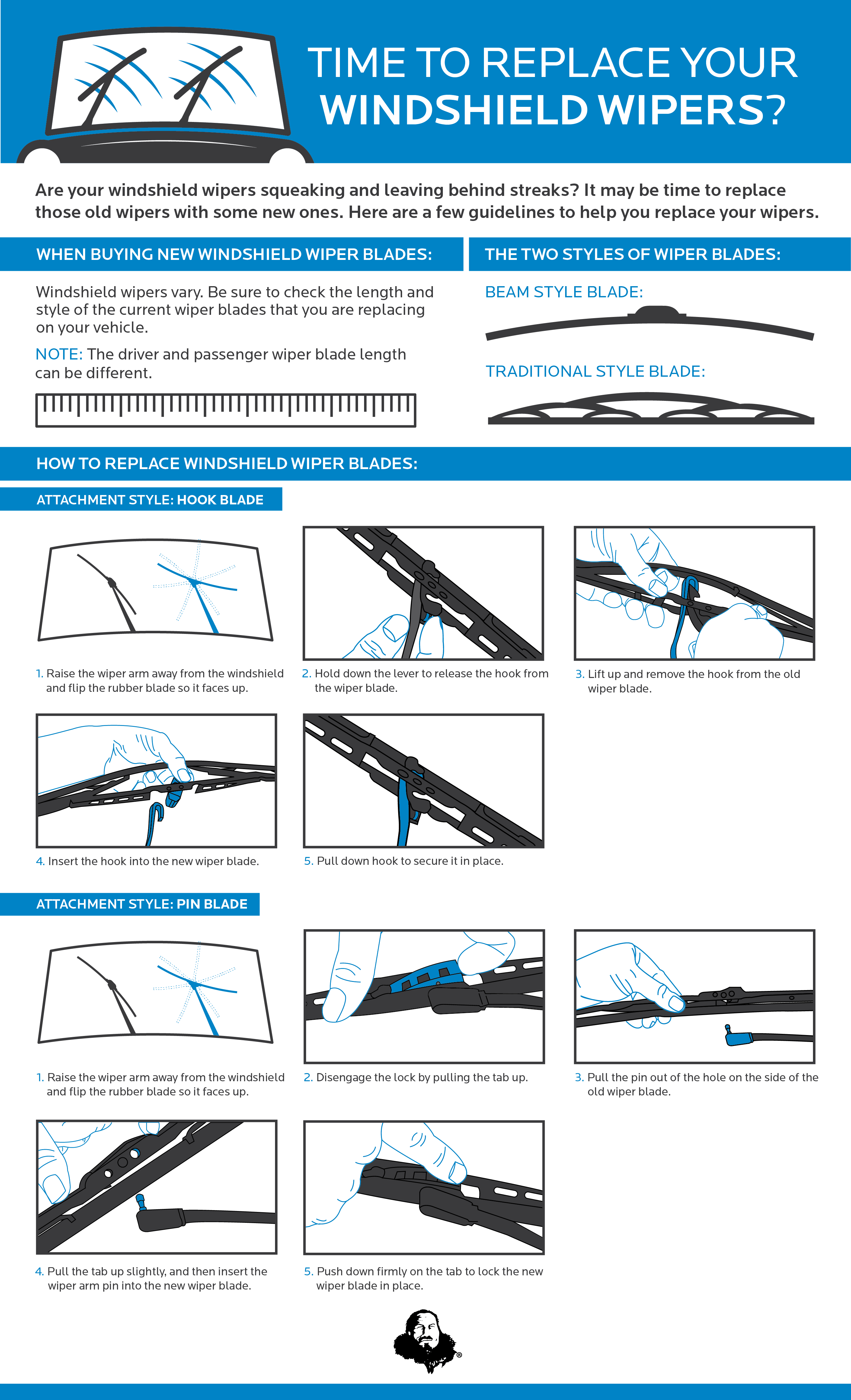Replacing your car’s wiper blades is crucial for maintaining clear visibility during rain or snow. Neglecting to do so can compromise your safety on the road.
Intelligent visibility is crucial for safe driving, and efficient wiper blades are a vital component in achieving this. Whether it is the rainy season or encountering unexpected showers, having clear visibility is essential to navigate the roads. Worn-out wiper blades may leave streaks, smudges, or fail to clear the windshield properly, obstructing your view and increasing the risk of accidents.
Regularly replacing your car’s wiper blades ensures optimal functionality and improves driving safety. Additionally, new wiper blades can better withstand harsh weather conditions, providing enhanced durability and preventing potential damage to your windshield. Don’t compromise on your safety – replace your car’s wiper blades to ensure clear visibility and peace of mind while on the road.

Credit: www.umialik.com
The Importance Of Wiper Blades
Ensuring your car’s wiper blades are in top condition is crucial for your safety on the road.
Safety On The Road
- Clear view: New wiper blades ensure a clear view of the road ahead in all weather conditions.
- Rainy weather: Improved blades help maintain visibility during heavy rain, preventing accidents.
Enhanced Visibility
- Night driving: Fresh wiper blades provide better visibility at night, enhancing safety.
- Snow and sleet: Upgraded blades effectively clear off snow and sleet, reducing the risk of collisions.
Signs Of Worn-out Wiper Blades
When it comes to car maintenance, one essential component that often goes unnoticed until it fails is the wiper blades. These small yet crucial parts play a significant role in keeping your windshield clear and ensuring optimal visibility during rain or snowfall.
Streaking On The Windshield
One of the telltale signs of worn-out wiper blades is streaking on the windshield. If you notice that your wiper blades create streaks of water or other residue when in use, it’s a clear indicator that they are no longer making proper contact with the glass. These streaks can obstruct your view and make it more difficult to see the road ahead, increasing the risk of accidents.
Chattering Or Skipping
Another sign that your wiper blades need replacing is a chattering or skipping motion. If you notice that your wiper blades make a chattering sound or skip across the windshield instead of smoothly gliding, it’s time to invest in a new pair. This problem usually occurs when the rubber edges of the blades become rigid or damaged, losing their ability to conform to the curvature of the windshield.
When wiper blades chatter or skip, they leave behind areas that are not properly wiped, reducing visibility and creating potential blind spots. This can be especially dangerous during heavy rain or snow showers, as it hampers your ability to respond quickly to hazards on the road.
How To Check For Worn-out Wiper Blades
If you’re unsure whether your wiper blades are due for replacement, there are a few simple checks you can perform:
- Inspect the rubber edges of the blades for any signs of cracking, tearing, or uneven wear.
- Run your fingers along the blade to feel for any roughness or irregularities.
- Test the wiper blades by operating them on a wet windshield and observing their performance.
Replacing your wiper blades at the first signs of wear and tear is crucial to maintaining clear visibility and ensuring your safety on the road. By staying vigilant and addressing these issues promptly, you can avoid potential accidents and enjoy optimal performance from your wiper blades.
Factors Affecting Wiper Blade Lifespan
Proper maintenance and regular replacement of your car’s wiper blades are essential for ensuring clear visibility during rainy or snowy weather. Over time, wiper blades can become worn, damaged, or ineffective, compromising their ability to effectively clear your windshield. However, the lifespan of wiper blades can vary depending on several factors. In this section, we will explore the different factors that can affect the lifespan of your car’s wiper blades.
Weather Conditions
One of the main factors that can affect the lifespan of your car’s wiper blades is the weather conditions they are exposed to. Harsh weather conditions, such as heavy rain, snow, or sleet, can put additional strain on the wiper blades, causing them to wear out faster. The constant movement of the wiper blades across the windshield, combined with the abrasive nature of rain or snow, can lead to the deterioration of the rubber blade, resulting in reduced performance.
Exposure To Uv Rays And Heat
UV rays and heat from the sun can also have a detrimental effect on the lifespan of your car’s wiper blades. Prolonged exposure to sunlight can cause the rubber blade to become dry, brittle, and prone to cracking. Additionally, high temperatures can accelerate the degradation of the rubber blade, further reducing its effectiveness. If you live in an area with intense sunlight or hot summers, it is important to regularly inspect and replace your wiper blades to ensure optimal performance.
By being mindful of these factors that can affect the lifespan of your car’s wiper blades, you can take proactive measures to ensure optimal visibility and safety on the road. Regularly inspecting the condition of your wiper blades and replacing them when necessary will help to maintain clear and streak-free windshield wiping, allowing you to drive with confidence, even in adverse weather conditions.
Credit: www.firestonecompleteautocare.com
When To Replace Wiper Blades
Ensure clear visibility in all weather conditions by replacing your car’s wiper blades every six months. Over time, blades can wear out, leading to reduced effectiveness and potential safety hazards while driving. Regular replacement is key to maintaining optimal windshield performance.
Routine maintenance schedule helps determine wiper blade condition. These small but essential components play a significant role in maintaining visibility during inclement weather. Routine Maintenance Schedule Inspect wiper blades regularly to ensure they are functioning optimally. Replace every six months or sooner if signs of wear are noticeable. Change in Performance Diminished performance such as streaking or skipping indicates the need for replacement. Visibility is compromised if blades are not effectively clearing the windshield. Code Example: “`htmlRoutine Maintenance Schedule
- Inspect wiper blades regularly
- Replace every six months or sooner if signs of wear
Change In Performance
- Diminished performance such as streaking or skipping
- Visibility is compromised if blades are not effectively clearing the windshield
Choosing The Right Wiper Blades
Types Of Wiper Blades
When it comes to choosing the right wiper blades for your car, it’s important to consider the various types available. Conventional wiper blades are the most common type and are suitable for most weather conditions. Alternatively, beam blades are designed to provide a more uniform pressure across the windshield, resulting in efficient wiping. Hybrid blades combine the durability of conventional blades with the sleek design of beam blades, making them a versatile option for different climates.
Consideration Of Climate
Considering the climate in which you’ll be driving is essential when selecting wiper blades. In areas with extreme temperatures, such as hot summers or freezing winters, all-season blades designed to endure various weather conditions are a wise choice. For regions with frequent rain or snow, winter wiper blades with a durable rubber cover will ensure optimal visibility during harsh weather.

Credit: www.tricoproducts.com
Frequently Asked Questions For Why Should You Replace Your Car’s Wiper Blades?
Why Do You Need To Replace Wiper Blades?
Wiper blades need replacing to maintain visibility, ensure safety, and improve performance during inclement weather.
What Happens If You Don’t Replace Wiper Blades?
Using worn-out wiper blades can impair visibility, leading to smearing, streaks, and decreased effectiveness. It can also cause damage to the windscreen, making it costlier to repair. Replacing your wiper blades regularly ensures clear visibility and safe driving.
Do New Windshield Wipers Make A Difference?
Yes, new windshield wipers do make a difference. They provide clearer visibility in rain and snow, ensuring safer driving conditions. Additionally, they prevent streaking and smearing on the windshield, improving overall windshield performance.
How Do You Know When Wiper Blades Need Replacing?
Inspect wiper blades for streaks, skipping, or squeaking. Replace if worn, cracked, or not clearing well.
Conclusion
Keep your vision clear and drive safely by replacing worn wiper blades regularly. Enhancing visibility during rain and snow is essential for road safety. Don’t overlook this simple yet crucial maintenance task for your vehicle’s overall performance and your well-being on the road.
Stay safe, see clearly.
